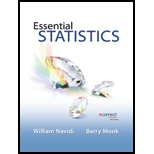
a.
Find the value of
a.
Answer to Problem 43E
The value of
Explanation of Solution
Calculation:
The table represents the probability distribution of the random variable X, the number of defects in a randomly chosen printed circuit board.
From the probability distribution table, the probability at the point
Thus, the value of
b.
Find the probability value,
b.
Answer to Problem 43E
The probability value,
Explanation of Solution
Calculation:
The required probability is the sum of the probabilities at
Substituting the values from the probability distribution table,
Thus, the probability value,
c.
Find the probability that at least two circuits are defective.
c.
Answer to Problem 43E
The probability that at least two circuits are defective is 0.20.
Explanation of Solution
Calculation:
The probability that at least two circuits are defective is the sum of the probabilities at
Substituting the values from the probability distribution table,
Thus, the probability that at least two circuits are defective is 0.20.
d.
Find the probability that no more than two circuits are defective.
d.
Answer to Problem 43E
The probability that no more than two circuits are defective is 0.90.
Explanation of Solution
Calculation:
The probability that no more than two circuits are defective is the sum of the probabilities at
Substituting the values from the probability distribution table,
Thus, the probability that no more than two circuits are defective is 0.90.
e.
Find the
e.
Answer to Problem 43E
The mean value is 0.80.
Explanation of Solution
Calculation:
The formula for the mean of a discrete random variable is,
The mean of the random variable is obtained as given below:
| x | P(x) | |
| 0 | 0.5 | 0 |
| 1 | 0.3 | 0.3 |
| 2 | 0.1 | 0.2 |
| 3 | 0.1 | 0.3 |
| Total | 1.00 | 0.8 |
Thus, the mean value is 0.80.
f.
Find the standard deviation.
f.
Answer to Problem 43E
The standard deviation is 0.98.
Explanation of Solution
Calculation:
The standard deviation of the random variable X is obtained by taking the square root of variance.
The formula for the variance of the discrete random variable X is,
Where
The variance of the random variable X is obtained using the following table:
| x | P(x) | |||
| 0 | 0.5 | –0.8 | 0.64 | 0.320 |
| 1 | 0.3 | 0.2 | 0.04 | 0.012 |
| 2 | 0.1 | 1.2 | 1.44 | 0.144 |
| 3 | 0.1 | 2.2 | 4.84 | 0.484 |
| Total | 1.0 | 2.8 | 6.96 | 0.960 |
Therefore,
Thus, the variance is 0.96.
The standard deviation is,
That is, the standard deviation is 0.98.
g.
Find the probability that the circuit will
g.
Answer to Problem 43E
The probability that the circuit will function if it has only one defect or no defect is 0.80.
Explanation of Solution
Calculation:
The probability that the circuit will function if it has only one defect or no defect is the sum of the probabilities at
Substituting the values from the probability distribution table,
Thus, the probability that the circuit will function if it has only one defect or no defect is 0.80.
Want to see more full solutions like this?
Chapter 5 Solutions
Essential Statistics
 MATLAB: An Introduction with ApplicationsStatisticsISBN:9781119256830Author:Amos GilatPublisher:John Wiley & Sons Inc
MATLAB: An Introduction with ApplicationsStatisticsISBN:9781119256830Author:Amos GilatPublisher:John Wiley & Sons Inc Probability and Statistics for Engineering and th...StatisticsISBN:9781305251809Author:Jay L. DevorePublisher:Cengage Learning
Probability and Statistics for Engineering and th...StatisticsISBN:9781305251809Author:Jay L. DevorePublisher:Cengage Learning Statistics for The Behavioral Sciences (MindTap C...StatisticsISBN:9781305504912Author:Frederick J Gravetter, Larry B. WallnauPublisher:Cengage Learning
Statistics for The Behavioral Sciences (MindTap C...StatisticsISBN:9781305504912Author:Frederick J Gravetter, Larry B. WallnauPublisher:Cengage Learning Elementary Statistics: Picturing the World (7th E...StatisticsISBN:9780134683416Author:Ron Larson, Betsy FarberPublisher:PEARSON
Elementary Statistics: Picturing the World (7th E...StatisticsISBN:9780134683416Author:Ron Larson, Betsy FarberPublisher:PEARSON The Basic Practice of StatisticsStatisticsISBN:9781319042578Author:David S. Moore, William I. Notz, Michael A. FlignerPublisher:W. H. Freeman
The Basic Practice of StatisticsStatisticsISBN:9781319042578Author:David S. Moore, William I. Notz, Michael A. FlignerPublisher:W. H. Freeman Introduction to the Practice of StatisticsStatisticsISBN:9781319013387Author:David S. Moore, George P. McCabe, Bruce A. CraigPublisher:W. H. Freeman
Introduction to the Practice of StatisticsStatisticsISBN:9781319013387Author:David S. Moore, George P. McCabe, Bruce A. CraigPublisher:W. H. Freeman





